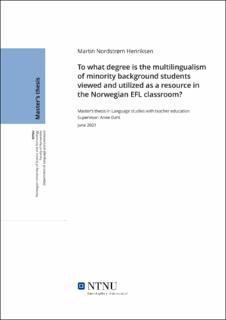| dc.contributor.advisor | Dahl, Anne | |
| dc.contributor.author | Henriksen, Martin Nordstrøm | |
| dc.date.accessioned | 2022-02-18T18:21:24Z | |
| dc.date.available | 2022-02-18T18:21:24Z | |
| dc.date.issued | 2021 | |
| dc.identifier | no.ntnu:inspera:80303918:22978664 | |
| dc.identifier.uri | https://hdl.handle.net/11250/2980175 | |
| dc.description.abstract | | |
| dc.description.abstract | This disserattion is a study of the degree to which minority background students get to utilize the whole of their multilingualism in the Norwegian EFL classrooms, discussing what languages are used in the EFL classroom and how this affects the minority background students.
As the Norwegian society at large has become more and more linguistically and culturally heterogenous over the last few decades as a result of immigration, so has the Norwegian EFL classroom. This requires English teachers to now be able fascilitate an educational context in which students with minority backgrounds get the chance to excell based on all their linguistic and cultural knowledge, just like their majority background peers.
This dissertation is a case study in which one teacher and three students are interviewed in an attempt to explore the degree to which the multilingualism of minority background students is viewed and utilized as a resource. Based on previous research on multilingualism in the EFL classroom, both in Norway and abroad, as well as relevant theory, the findings from the interviews are discussed.
The main finding of this dissertation is that the home languages of the minority background students who participated were not viewed or utilized as resources in the EFL classroom. | |
| dc.language | eng | |
| dc.publisher | NTNU | |
| dc.title | To what degree is the multilingualism of minority background students viewed and utilized as a resource in the Norwegian EFL classroom? | |
| dc.type | Master thesis | |
